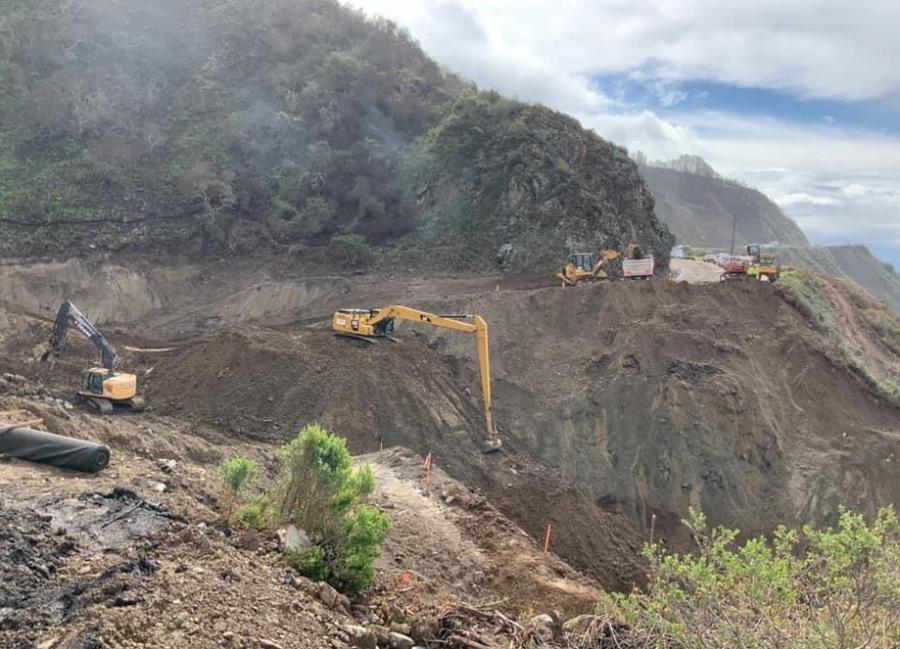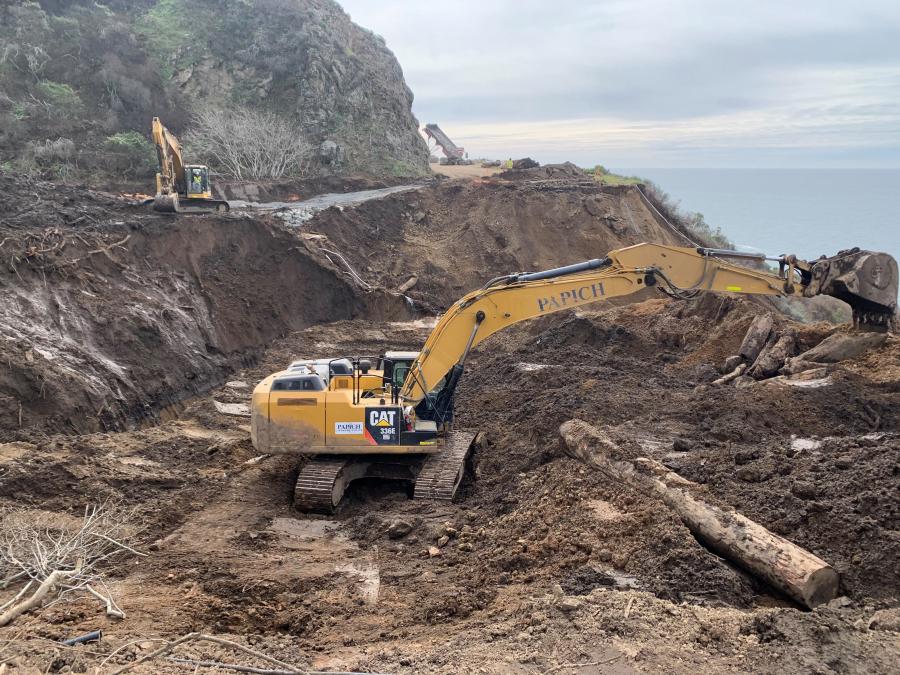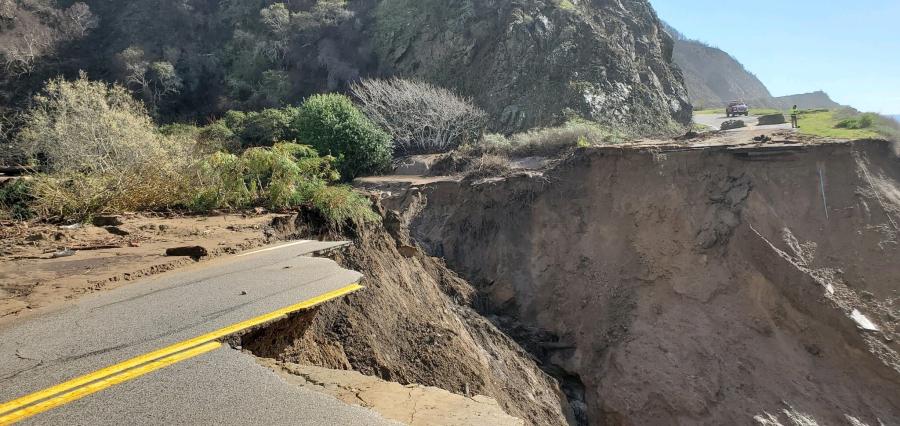At noon on April 23, two months ahead of schedule, the California Department of Transportation (Caltrans) was able to re-open the highway to traffic.
Highway 1, California's scenic highway that runs along the Pacific Coast, experienced a serious washout at Rat Creek in Monterey County on Jan. 28 when a post-fire debris flow from the Dolan Fire burn scar removed a 150-ft. wide, two-lane section of the roadway built in the 1930s.
The debris flow, consisting of boulders, sediment and trees and vegetation, overwhelmed the existing culvert. The debris and water crashed down the canyon onto the highway, causing it to collapse and took a large portion of the hillside below it.
This resulted in a full road closure 2 mi. north and 3 mi. south of Rat Creek on the Big Sur Coast as crews from Papich Construction Company worked to rebuild the highway on unstable ground.
Construction/Repairs
In order to initiate the repair process, the first step was to remove the debris. This was no easy task due to the instability of the ground to support the heavy equipment. Papich operators used a Cat 336 excavator and John Deere excavators.
"We had more than 10 excavators at one time, most of them being larger sizes," said Randy Anderson, Papich's project manager. "We also had three longstick excavators that we used primarily to reach the middle of the debris flow. The flow was very unstable — it primarily consisted of saturated soil, wood and rock. We had to work into it from the perimeters and we used some of the logs from the debris to create temporary working platforms. It was an innovative approach.
"Every morning we would have a safety meeting to discuss the day's work and with up to 30 people at any given time over the past three months to explain where we were at and the hazards to expect," he added. "Safety was always at the forefront. We didn't have one injury to our crews or the travelling public. We had more than 60 loads of equipment mobilizing up both sides of the highway, which was very curvy, with places where two cars could barely pass."
Concerns about loose rock and debris are ever present, but fortunately there were no close calls during this phase. As the crews removed more debris, preparations were ongoing to bring slide material from another landslide area, 3 mi. away, to use for the filing operation.
"It was ideal material for use as the moisture content and the minimal rock size was perfect for a fill of this type," said Anderson. "It was ideal, especially knowing that we would have to tunnel through it again."
As the excavation was ongoing, some blasting was required to remove some of the existing rock in the new culvert alignment.
"We were told that when the highway was constructed, they put a culvert at the bottom of the canyon and filled over it with whatever materials they had," said Anderson. "Once this culvert was plugged, the debris flow reached the roadway surface, overflowed and washed out the road and hillside."
Temporary haul roads to the bottom of the canyon were required to reach the debris at the lower levels. The trees that were swept down helped with this effort, especially those that were 40-ft. tall.
"We worked our way in to build the access roads and with excavators we leapfrogged the material out to where it could be loaded into trucks from ATI Trucking," said Anderson. "At times we had up to 40 trucks hauling material to the stockpile sites. Right now we're working to remove about 25,000 yards that we temporarily stockpiled through the clean-up process."
Most of the work to place the fill was conducted with Cat and John Deere dozers and compactors.
"We started with a smaller vibratory deep compactor, a sheepsfoot compactor, and once we got high enough and had enough room on the bench, we brought in a Cat 815 compactor," said Anderson. "We brought in between 1,500 to 1,800 cubic yards of import a day.
"At the end of a shift, we brought the equipment above the flow just in case something could have happened," said Anderson. "This was where we would fuel our equipment."
Pacific Boring will be brought in to do the boring.
"They felt that having 10 feet of fill over the top of the proposed culvert would be adequate to allow them to start their operations while the highway was open," said Anderson.
Prior to the road construction, two 24-in. culverts and a 60-in. diameter corrugated metal pipe culvert were installed above the newly designed 10-ft. culvert. The two 24-in. culverts were placed so that should a similar incident happen again, Caltrans crews can reach down and clear the opening to keep water from overtopping the road surface and washing out the road.
With the new pipe coming in, engineering is crucial.
"This is probably going to be the toughest phase of the job as far as using engineering and survey," said Anderson. "We brought in a structural engineer to help us with the backboard construction that the tunneling device will push against to push the casing through. The subcontractor did a mock-up in their construction yard to make sure that the equipment could operate properly and give them the confidence that they can make this work."
The new road consists of two 12-ft. lanes with two 4-ft. shoulders and a berm on the downhill side. Guardrail will be placed on the west side, which will protect a 100-ft. slope down to the ocean below.
The road section consists of 18 in. of Class 2 base, topped with 6 in. of a warm mix design HMA.
"Our warm mix designs are a new technology that Caltrans has adopted for long-range projects," said Anderson. "It stays warmer much longer. For the road construction, Cat pavers and rollers and John Deere blades were employed.
Superintendent Augie Wilhite and Foreman Todd Bright have been indispensable in the progress of the project.
"Todd went up with both Jason Papich, the owner and myself," said Anderson. "We were called on January 28 when the water was starting to over-crest the highway. We were on our way from the north side of Monterey and when we got there on January 29, the road was washed out. We arrived at 9 a.m. and started formulating a plan to get equipment on the road. We were working on January 30 and had mobilized 10 pieces of equipment by that morning.
"Todd and Augie worked side-by-side the whole time," he added. "Most of the guys worked three straight months. We never stopped, even when it rained. In the end, we had total of two lost days due to shutdowns. Mother Nature treated us well."
Peak days had 30 Papich and 15 subcontractor employees on-site, putting in 12 to 13 hour every day for 85 days.
"We had standby equipment on site just in case some equipment broke down and a full-time mechanic to make sure any break downs were mitigated," said Anderson. ‘We had a 10,000 gallon fuel trailer that we shuttled to the equipment every night. I've been in this business for 42 years and this was our biggest challenge. It was the most rewarding job that I had in my entire career."
The subcontractors include Dean's Welding; Super Seal, and Stripe; Myers Drilling; and Avila Traffic Safety.
Materials brought in for the new road included 1,600 tons of asphalt and 3,000 tons of base.
Papich purchases and rents equipment from dealerships such as Isco Machinery Rentals and United Rentals, and Quinn Company, which supplies Cat equipment.
"We have very good relationships with the dealerships locally," said Anderson. "We're one of the bigger contractors in the area, so they cater to us and help us. They were instrumental in helping us get the project done. We would call on a Sunday and they would have a part in the dropbox on Monday morning. They worked seven days a week along with us, making sure we got what we needed.
"Our material suppliers, Granite Rock to the north and Crye Excavating to the south, were instrumental with their timely deliveries," he added. "We had to have the cooperation of everyone to make this work and it happened."
At noon on April 23, two months ahead of schedule, the California Department of Transportation (Caltrans) was able to re-open the highway to traffic.
"Final roadway paving has advanced at a pace that allowed for this reopening, which is two months earlier than previously announced," said Kevin Drabinski, Caltrans public information officer of District 5. "This was welcome news indeed for residents, recreationalists, business owners and those who move goods through this region. The construction phases for this emergency project were ordered to allow for the rapid reopening of the road, even as remaining construction tasks are being completed."
Additional Construction
The additional construction activities, to be completed over the next few months, cover the installation of a 10-ft. diameter culvert casing, permanent guardrail to replace the K-rail now in place, the construction of headwalls at the culvert inlets, final grading features, and the placement of erosion control measures on both sides of the roadway.
The fires that led to the debris flow raged for about 1.5 months in the interior and along the coast before being out. The flow, which began on Jan. 28 and during the morning hours of Jan. 29, overwhelmed the infrastructure to bring down the road. Fortunately no one was injured or killed.
By installing a much larger culvert and putting in place a redundant drainage system, Caltrans is hoping to avoid a future washout. Prior to the washout, a 6.5 ft. diameter culvert provided the protection. It is being replaced with a 10-ft. diameter system designed to let more debris pass through the infrastructure.
"Our engineers felt that had we only had 17 inches of rain in late January, the existing culvert would have held," Drabinski told the Monterey Herald. "What was different about this event was the debris flow from the Dolan Fire burn scar. The design addresses the possibility in the future of a fire followed by a major rain event."
One component yet to be started is a tunneling operation to install a 10-ft. diameter, 1-in. thick steel pipe culvert which will pass from the canyon, through the fill below the roadway and out to the ocean.
"This key piece of infrastructure will substantially improve water flow capacity during future storm events," said Drabinski. "It will be augmented by a 5 ft. diameter culvert and two 24 inch culverts, which have already been installed closer to the grade of the highway. The redundancy of the drainage infrastructure is designed to make the highway more resilient to extreme weather conditions which will allow for safe travel."
"Sequencing the phases of construction allows the road to be open while construction continues," said Drabinski. "We'll be able to manage that and other construction items with intermittent traffic control."
Approximately 70,000 cubic yards of debris — earth, rock, vegetation and asphalt — was removed from the canyon while a repair design strategy was being evaluated. The material was taken permanent and temporary stockpile sites within a 15 mi. radius of Rat Creek.
An enhanced fill strategy, which replaced the lost ground to support the new road, was identified and approved in late February. This led to crews placing 45,000 cu. yds. of fill dirt, capable of being compacted to support the roadway above.
While the highway has re-opened, the remaining construction work will require intermittent traffic control at the washout site, which may cause delays of up to 10 minutes. Caltrans has placed message and directional signs to alert motorists when one-way reversing traffic control is needed.
The reconstruction project, financed by Caltrans from a state emergency fund, will cost $11.5 million. CEG
Irwin Rapoport
A journalist who started his career at a weekly community newspaper, Irwin Rapoport has written about construction and architecture for more than 15 years, as well as a variety of other subjects, such as recycling, environmental issues, business supply chains, property development, pulp and paper, agriculture, solar power and energy, and education. Getting the story right and illustrating the hard work and professionalism that goes into completing road, bridge, and building projects is important to him. A key element of his construction articles is to provide readers with an opportunity to see how general contractors and departments of transportation complete their projects and address challenges so that lessons learned can be shared with a wider audience.
Rapoport has a BA in History and a Minor in Political Science from Concordia University. His hobbies include hiking, birding, cycling, reading, going to concerts and plays, hanging out with friends and family, and architecture. He is keen to one day write an MA thesis on military and economic planning by the Great Powers prior to the start of the First World War.
Read more from Irwin Rapoport here.
Today's top stories























